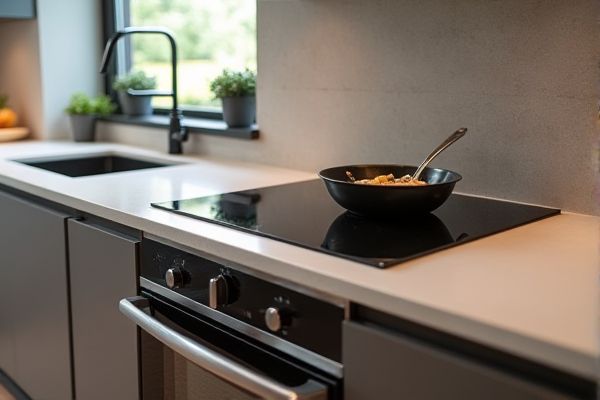
Induction stovetops use electromagnetic fields to heat your cookware directly, offering faster and more energy-efficient cooking compared to traditional electric stovetops, which rely on heating elements to warm pots and pans. Discover the key differences in performance, safety, and cost in the rest of the article to decide which stovetop suits your kitchen needs best.
Table of Comparison
| Feature | Induction Stovetop | Electric Stovetop |
|---|---|---|
| Heating Method | Electromagnetic induction heats cookware directly | Electric coils or radiant heating elements heat cookware |
| Energy Efficiency | Up to 90% efficient | Around 70% efficient |
| Heat Response Time | Instant heat adjustment | Slower heat changes |
| Cookware Compatibility | Requires magnetic cookware | Works with all cookware types |
| Surface Temperature | Remains cooler, safer to touch | Surface gets very hot |
| Cleaning | Easy, flat surface | Can be harder due to coils or grooves |
| Cost | Higher initial price | Generally affordable |
| Safety Features | Auto shut-off, cool surface | Less advanced safety controls |
Introduction: Induction vs. Electric Stovetops
Induction stovetops use electromagnetic fields to heat cookware directly, offering faster and more energy-efficient cooking compared to traditional electric stovetops that rely on heating elements. Electric stovetops often feature coil or smooth glass-ceramic surfaces, taking longer to heat and cool while consuming more electricity. Induction models provide precise temperature control and enhanced safety by heating only compatible pots and pans.
How Induction Stovetops Work
Induction stovetops use electromagnetic fields to directly heat pots and pans, making cooking faster and more energy-efficient than traditional electric stovetops that rely on heating elements. The induction coil beneath the cooktop generates a magnetic field that induces electric currents in ferrous cookware, instantly raising its temperature. Your choice of cookware is crucial, as only magnetic materials like cast iron or stainless steel are compatible with induction technology.
How Electric Stovetops Operate
Electric stovetops operate by passing an electric current through resistive heating elements, converting electrical energy into heat that is transferred to cookware. These elements, either exposed coils or concealed beneath glass-ceramic surfaces, heat up and provide consistent, steady temperature control ideal for simmering or boiling. Your cooking efficiency depends on the direct heat conduction from these elements to the pot or pan, which differentiates electric stovetops from induction models that use magnetic induction for faster, more precise heating.
Energy Efficiency Comparison
Induction stovetops convert approximately 85-90% of electrical energy into heat directly in the cookware, making them significantly more energy-efficient than electric stovetops, which typically convert only 65-70%. The rapid heating mechanism of induction reduces energy waste and cooking time compared to electric coil or smooth-top models. Studies show induction cooking can reduce overall energy consumption by up to 30%, contributing to lower electricity bills and a smaller carbon footprint.
Cooking Speed and Temperature Control
Induction stovetops use electromagnetic fields to heat pots directly, allowing them to reach high temperatures rapidly and provide precise temperature adjustments for cooking. Electric stovetops rely on heating elements that warm slowly, resulting in slower cooking speeds and less accurate temperature control. Induction technology enhances efficiency and responsiveness, making it superior for tasks requiring quick temperature changes.
Safety Features and Concerns
Induction stovetops offer enhanced safety features by using electromagnetic fields that heat only the cookware, reducing burn risks and minimizing accidental ignition hazards. Electric stovetops maintain heat even after being turned off, posing potential fire concerns and requiring caution around hot surfaces. Your choice should consider the lower risk of burns and faster cool-down times associated with induction technology for improved kitchen safety.
Cookware Compatibility Requirements
Induction stovetops require cookware made of ferromagnetic materials such as cast iron or stainless steel with a magnetic bottom to generate heat efficiently. In contrast, electric stovetops are compatible with a wider range of cookware materials, including glass, aluminum, and copper, as they use radiant heat elements. Ensuring proper cookware compatibility is essential for optimal performance and energy efficiency on induction stovetops.
Cleaning and Maintenance Differences
Induction stovetops feature a smooth, flat glass surface that resists spills and allows for easy wiping without disassembling components, making them simpler to clean compared to traditional electric stovetops. Electric stovetops often have coils or raised burners that can trap food debris, requiring more effort to remove and clean thoroughly. Your choice between these stovetops will impact the time and effort spent on their regular maintenance and cleaning routines.
Initial Cost and Long-Term Value
Induction stovetops typically have a higher initial cost, ranging from $1,000 to $3,000, compared to electric stovetops, which usually cost between $400 and $1,500. Despite the upfront expense, induction cooktops offer long-term value through improved energy efficiency, faster cooking times, and reduced heat loss, lowering electricity bills by up to 30%. Electric stovetops, while cheaper initially, tend to have higher operating costs and longer cooking durations, making them less cost-effective over time.
Which Stovetop is Best for Your Kitchen?
Induction stovetops offer rapid heating, precise temperature control, and energy efficiency, making them ideal for modern kitchens focused on speed and safety. Electric stovetops provide consistent, even heating and tend to be more affordable and compatible with a wider range of cookware. Your choice should consider factors like cooking style, budget, and cookware compatibility to select the best stovetop for your kitchen needs.
 homyna.com
homyna.com